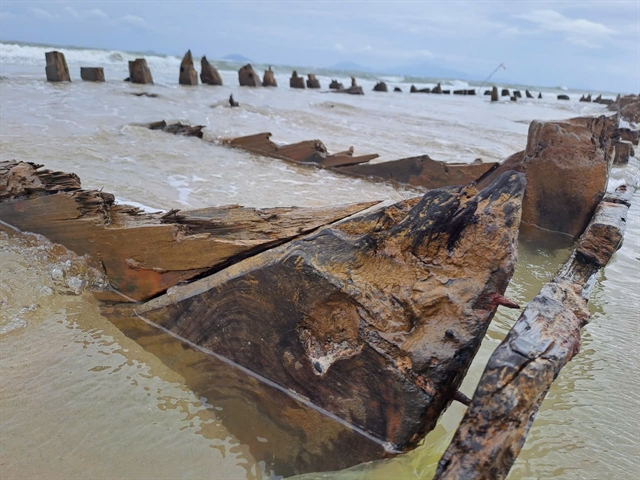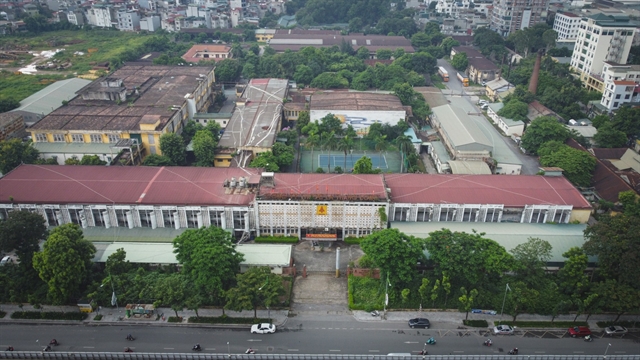 Life & Style
Life & Style


|
| The ancient shipwreck seen from the front on the beach of Hội An ancient town. An attraction for local and international visitors, the artefact was exposed on the beach in early November. — VNS Photos Công Thành |
HỘI AN — A shipwreck exposed by erosion earlier this month on a Hội An beach after recent floods will need detailed surveys and excavation plans, as well as solutions for preserving the ship's remains for long-term archaeological research and exhibition, experts say.
At a recent talk on the shipwreck, top history and archaeology researchers agreed on the importance of a large-scale excavation and expanded preservation activities, along with public display of the massive artefact.
Nguyễn Ngọc Quý from the Việt Nam Institute of Archaeology suggested an urgent excavation at the site before removing the shipwreck for long-term restoration and preservation in a museum space. It would be the first such display in central Việt Nam.
He said simple retaining walls could be used to make a protective dike for digging deep into the sand beneath the shipwreck, before lifting it up by crane.
“We expect that a powerful steel frame will be used to fix the shipwreck after a large sand excavation inside Larssen walls. Two crane trucks with 50-tonne loading capacity each could lift the shipwreck for removal to a designed outdoor museum space,” he said.

|
| Timber structures on the shipwreck on the beach of Hội An is naturally kept untouched for long time. An excavation plan has been prepared by Đà Nẵng City for soon implementation in early 2026. |
Quý said it would take around 30 days to complete an urgent excavation and removal of the shipwreck, which could be done by the end of December. Restoration would take at least one year, he added.
Centre for Southeast Asia Prehistory Director Nguyễn Văn Việt said the location of the shipwreck on the beach of Hội An offers the best conditions for a large-scale excavation of the artefact.
He noted that only a fifth of the rear section of the ship is still buried deep in sand, while almost all of the main deck is exposed above ground.
Việt warned that the seabed at the site should be identified before the shipwreck is moved ashore, adding that a field research room will be required for quick examinations on the excavation, or for artefacts collected from the ship.
A museum on ancient ships should also be built in the town for tourism and archaeological activities, he suggested.
Former Party Secretary of Hội An Nguyễn Sự said the excavation of the shipwreck could be done starting in April, which has more convenient climate conditions, as the ship has been buried on the beach for a very long time.
He said as a remnant of the area's ancient coastal fishing community, the ship is not located in deep sea water. Thus, he argued, it will be fairly simple to excavate in 2026. Meanwhile, Hội An has not yet recovered from heavy damage due to the historical flooding and massive beach erosion from this year's storms.
A report from the Hội An World Cultural Heritage Conservation Centre revealed that the vessel was a large and strong structure built for long sea voyages in the Southeast Asian region centuries ago, although the exact time period of its manufacture is as yet unknown. The latest survey showed that the ship measures 17.4m in length and over 5m in width.
Due to being buried, ship has naturally been untouched, and is in a very good condition for preservation of Hội An's first ancient beach shipwreck, the centre reported.
According to the report, ancient ceramic fragments (believed to date from between the 17th and 18th centuries) have previously been found in the area. More than 20 shipwrecks thus far found in the East Sea date from the 14th to the 16th centuries.

|
| Timber beams on an ancient shipwreck have been well preserved for centuries. The timber sections are connected with iron nails and joints. |
Hội An ancient town, a UNESO-recognised world heritage site, was a busy trading port in central Việt Nam from the 14th century, and many shipwrecks could be scattered in the waters off the coast, the centre said.
In 1997, a shipwreck near the Chàm Islands 20km off the coast of Hội An town was salvaged. The remains of the ship measure 29.4m long and 7.2m wide. Many other ancient artefacts have been collected for display at different museums in central Việt Nam.
Trần Đình Thành, an official from the Ministry of Culture, Sports and Tourism’s Department of Cultural Heritage, said that the new Đà Nẵng City (following its merger with Quảng Nam Province and Hội An ancient town) has implemented surveys and preparation for the shipwreck's excavation and preservation.
Thành said the best solutions will be selected after detailed discussions with top experts and archaeological agencies, and the excavation will be undertaken when the weather turns more favourable, in early 2026.
He said at least six excavations of ancient shipwrecks have already taken place in Việt Nam, with two ships found near the coast of Quảng Ngãi Province.
This particular shipwreck, which was exposed after flooding caused by Typhoon Kalmaegi in early November, is now on the beach section behind the Boutique Hội An Resort at 34 Lạc Long Quân Street, just five kilometres from the Old Quarter of Hội An ancient town.
It has attracted a lot of attention from local and international visitors since early November, as the site is very close to the beach and pedestrian access. — VNS




